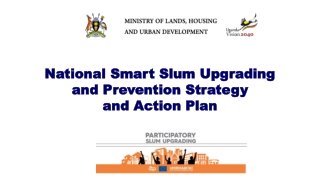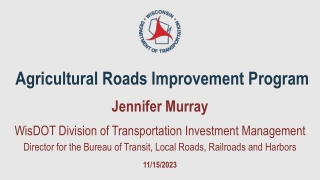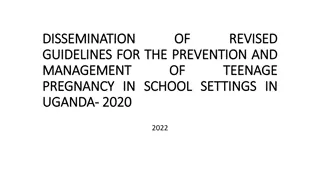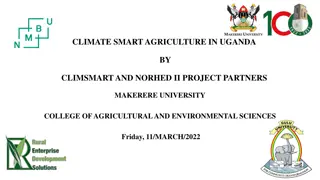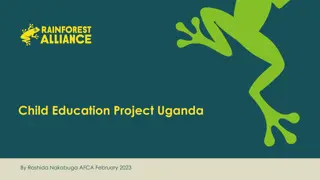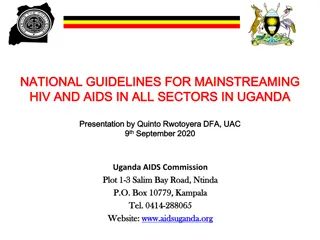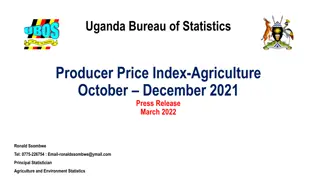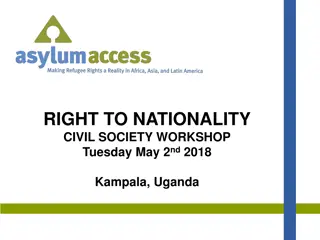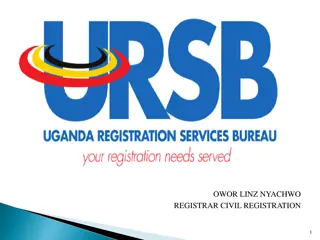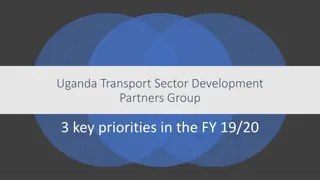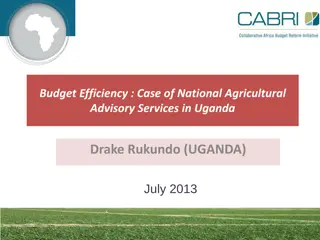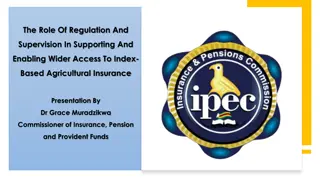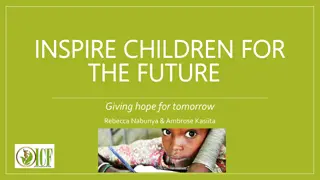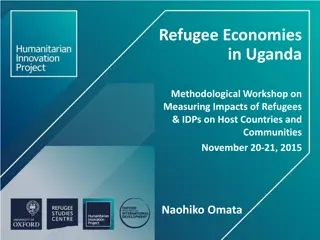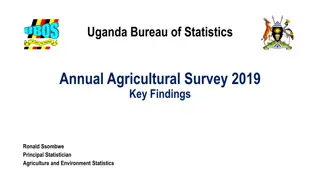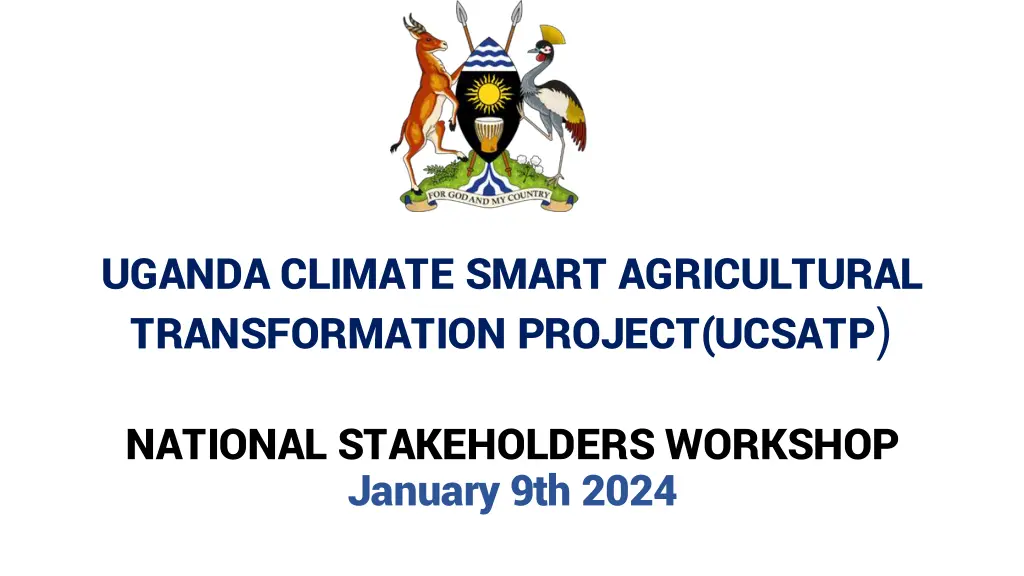
Uganda Climate Smart Agricultural Transformation Project Workshop
"Explore the Uganda Climate Smart Agricultural Transformation Project workshop held on January 9th, 2024. Discover the project's components, investments, budget, and stakeholders involved in this national initiative aimed at sustainable agriculture and environmental resilience."
Download Presentation

Please find below an Image/Link to download the presentation.
The content on the website is provided AS IS for your information and personal use only. It may not be sold, licensed, or shared on other websites without obtaining consent from the author. If you encounter any issues during the download, it is possible that the publisher has removed the file from their server.
You are allowed to download the files provided on this website for personal or commercial use, subject to the condition that they are used lawfully. All files are the property of their respective owners.
The content on the website is provided AS IS for your information and personal use only. It may not be sold, licensed, or shared on other websites without obtaining consent from the author.
E N D
Presentation Transcript
UGANDA CLIMATE SMART AGRICULTURAL TRANSFORMATION PROJECT(UCSATP) NATIONAL STAKEHOLDERS WORKSHOP January 9th 2024
Presentation Outline Proposed Components, investments & Budget Project Summary 1 4 Background and statement of the Problem Selection of districts & Value chains 2 5 Annex: Selected districts and value chains Project Relevance 3 6
Project Title The Uganda Climate Smart Agricultural Transformation Project (UCSATP) P173296 USD 354.7 million USD 350 Million USD 4.7 Million Project ID Total Financing Project Total External Funding Government of Uganda Counterpart Funding Approval Processess Development Committee Approval Presentation to Top Technical Ministry of Finance Planning and Economic Development Presentation to Top Management Ministry of Finance Planning and Economic Development Project Negotiations with World bank Approval by the World Bank Approval by Cabinet Approval by Parliament Project period Number of Districts approved Approved 15th November, 2022 18th November, 2022 23rd -25th November 2022 December,2022 September 2023 November 2023 6 years 69
Effectiveness Conditions Project Implementation Manual Under process Refugee Protection Framework Adequate Establishment of the National Project Coordination Unit Under process Project Beneficiaries Direct Project Beneficiaries (Numbers) 3,900,000 Direct Beneficiaries (Households)(Numbers) 760,000 Female beneficiaries (Number) 1,560,000.0 Refugee beneficiaries (households) (Number 60,000 Host Community* beneficiaries (households) (Number) 80,000 Indirect beneficiaries (Number) 9,500,000.
Background: Why Climate Smart Agriculture Mitigation Adaptation CSA Sustainable Household Food, Nutrition and Income Security Food security ,Productivity, Income
Project relevance The project is consistent with three Programs of NDP III Agro-industrialization Regional Development Whose commercialization competitiveness production and agro-processing. goal is to increase That aims to accelerate equitable regional economic development and growth and of agricultural Climate Change, Natural Resources, Environment and Water management program That aims to stop and reverse the degradation of water resources, environment, natural resources and effects of climate change on economic growth and livelihood security
Project Relevance NRM Manifesto and Presidential Directives Parish Development Model Agricultural Value Chain Development Strategy (AVDS) (2021-2026) Farmer education and Mobilization; Agricultural Mechanization Irrigation, Disease Control, Partnerships with large scale Farmers ,Proactive interventions in the Fisheries sector; Increase seed multiplication, distribution certification Enterprise selection; Production and Productivity; Harvesting, post harvest handling and Primary Processing, Agro- processing and Value addition; the Market Production, Processing and Marketing (Value Chain Development); Infrastructure and Economic Services; Inclusion; Community Data (Community Information System) Mindset change; ; Governance and Administration and Financial production, and 01 02 03
Project Development Objective(PDO) and Components PDO:To increase productivity, market access and resilience of selected value chains in the project area and to respond promptly and effectively to an eligible crisis or emergency Component 1 Component 2 Component 4 Component 5 Component 3 Project Coordination, Management, Monitoring, Evaluation and Learning Strengthening Climate-Smart Agricultural Research, Seed, and Agro-Climatic Information Systems Contingency Emergency Response Promoting Adoption of Climate Smart Agriculture Technologies and Practices Market Development and Linkages for Selected Value Chains
1.0: Strengthening Climate-Smart Agricultural Research, Seed, and Agro-Climatic Information Systems This component will support the development, validation, packaging, and dissemination of context- specific CSA Technologies, Innovations & Management Practices (TIMPs) to target beneficiaries Sub-component 1.4. Strengthening Institutional Capacity for Development and Dissemination of CSA TIMPs Sub-component 1.1 Supporting Research Innovations. Component One CSA and Sub-component 1.3. Strengthening Agro-Climate Monitoring and Information Systems Sub-component 1.2: Building Competitive and Sustainable Seed Systems .
Component 1: Strengthening Climate-Smart Agricultural Research, Seed, and Agro-Climatic Information Systems Sub-component 1.1: Supporting CSA Research and Innovations. Subcomponent will provide; Sub-component 1.3. Strengthening Agro-Climate Monitoring and Information Systems Sub-component 1.2: Building Competitive and Sustainable Seed Systems Sub-component 1.4. Strengthening Institutional Capacity for Development and Dissemination of CSA TIMPs Supports multiplication of seed and strengthening seed systems Support: Improve agro- meteorological forecasting, monitoring, data use, and soil testing Key Actors: MAAIF, UNMA, NARO, and the ZARDIs Support: Refurbishment and upgrade infrastructure for breed seed and improved seed production & Animal feeds Supports: Adaptive and Active research Key actors: MAAIF, ANGRCs, NAGRC&CB, ZARD s, private sector, farmer groups and large- scale farmers Instrument: Matching grants to support sustainable seed multiplication and production Key actors: NARS Scientists, Graduate Training of Scientists (Msc, PhD) Key actors: NARO, MAAIF, ANGRCs, NAGRC&CB, ZARD s, . . . Instrument: direct financing to support real time delivery of weather information and advisories as well as soil information and advisories Instrument: direct financing to support breeding programs to sustainably produce crop, livestock and fisheries seed and PPS for feeds Instrument: Competitive Research Grants to help adapt TIMPS to local conditions and address emerging research issues.
Key Investments in Subcomponent 1.1Supporting Climate-Smart Agricultural Research and Innovations Include 01 Develop, adapt, validate and deploy climate resilient and superior varieties, breeds and strains and other context specific CSA technologies, innovations and management practices for the selected value chains Characterize Cattle breed (indigenous, crosses and pure breeds) to define genetic attributes of cattle genetic resource Uganda and the environments to which they are adapted or known to be partially or not adapted to at all.. 02 03 Conducting of Adaptive and Applied Research in CSA selected value chains Facilitate professional development in specialized disciplines (livestock, crop, fisheries and climate science) 20 PhD, 40 MSc in CSA and other specialized areas 04 The Investments in the subcomponent address the presidential directive dated 31st May 2022 Page1 on Seed production, Multiplication distribution and Certification.
Sub-component 1.2: Key Investments Establish a national fish brood stock center at Kajjansi and at the 9 Zardis 01 02 "150 candidate varieties evaluated for DUS; 150 candidate varieties evaluated for NPTs" 1 Seed Tracking and Tracing System deployed, 5000 seed actors able to access and use the STTS, and Assorted ICT required to manage and use the system procured 03 Enhance animal disease detection, diagnosis and response through an efficient national animal laboratory system. A national laboratory system for collection, processing, dispatch, analysis of samples and dissemination of results 04 Establishment of 144 sub-county-based AI sub centres (delivery of AI inputs to the community, synchronization and artificial insemination, train 2 AI technicians per sub county, AI kits, and Assorted Reproductive Hormones) 05 06 Support to inspection, verification, and certification made for the 5 years of the project The Investments in these sub-components address the presidential directive dated May 31st 2022 Page 2-3 on 1) Animal breeding and use of the Artificial Insemination services at the subcounty and 2) Disease Control
The Key investments in Subcomponent 1.3 Acquire and establish new weather monitoring stations (37 AWS and 30 manual stations) and Rehabilitate and upgrade the existing 30 weather stations Upgrade and operationalize Weather Information Dissemination System (WIDS) using ICT platforms such as cell phones, websites, etc to disseminate agro-meteorological information. Build capacity of district extension staff, district farmers associations, farmers groups, women groups, youth groups, community leaders, NGOs, CBOs,CSOs, media and seed companies as weather information dissemination champions in the interpretation of weather forecast Set up climate information champions to participate in the multistakeholder platforms for development of area specific advisories that support farmers in planning and decision making across all the 18 Zones Establish soil organic carbon monitoring reporting and verification system to track implementation, adoption and impact of TIMPs 01 02 03 04 05 The Investments in these sub-component address the presidential directive dated 31st May 2022 Page 4 on Farmer Education and Mobilization. It s a key steps to precision agriculture or farming
Sub component 1.4 Key Planned Investments Develop and refurbish infrastructure for technology multiplication of animal genetic resources at 4 Animal Genetic Resources Centers (AnGRCs) (Serere, Rubona, Aswa, Maruzi) 01 Procure 12 Mobile Assisted Reproductive Technology (ART) laboratory and equipment to support Community Breeding Construct and/or operationalize 3 Regional livestock cattle pests and disease diagnostic laboratories and 69 District Laboratories. 02 03 Refurbish 4 regional feed equipment for formulating feed at regions and Develop 4private seed hatcheries at the regions under ppp arrangements Establish/Rehabilitate 7 mother gardens to support production of early generation seed of targeted value chains (coffee, banana, mangoes and citrus, cassava, cocoa and cashewnut) at ZARDIs. 04 05 06 07 Expand and maintain 7 irrigation facilities to support off-season seed production for target value chains at the ZARDIs Construct data center to support early warning system and advisory services The Investments in these sub-component address the 31st May 2022 presidential directive on the policy proposals for the development of the agricultural sector specially on seed production, multiplication distribution and Certification; Animal breeding and use of the artificial Insemination services
Effective Delivery mechanism of the Subcomponent Direct financing for national level infrastructure Competitive Research Grants 01 04 Public Private partnerships Graduate research assistantship 05 02 06 Internships Matching grants 03
Sustainability-1 Better management of infrastructure NARO & Government - lobby for international research grants 01 04 Development of fish feed market system Competitive and collaborative research for graduate research Development seed markets 05 02 Continued government support to research 06 03
2.0: Promoting Adoption of Climate Smart Agriculture Technologies and Practices The component will support investments for up-scaling and adoption of climate-smart agriculture (CSA) technologies, innovations, and management practices (TIMPs) developed in Component one. It has 3 Sub-components Sub-Component 2.1 Productivity Enhancement and Resilience Investments for income generation Sub-component 2.3. Sub-component 2.2 Building institutional capacity for productivity enhancement, resilience, and strengthening service delivery Productivity enhancement and resilience for food and nutrition security in refugee settlements
Component Two: Promoting Adoption of Climate Smart Agriculture Technologies and Practices Sub-component 2.2: Productivity enhancement and resilience for food and nutrition security in refugee settlements Support: Increased enhanced resilience of agricultural value chain to CC, and to enhance and food security and nuitrition Key actors: refugee settlements and host communities Instruments1: grants for seeds, fertilizers, micro-irrigation kits and mechanization to Farmer groups Sub-Component 2.1. Productivity Enhancement and Resilience Investments for income generation Support: Increased productivity and enhanced resilience of agricultural value chain to CC, as well as reduced GHG emissions Key actors: Crop livestock and fisheries farmers and farmer groups non refugee host & host communities Sub-component 2.3. Building institutional capacity for productivity enhancement, resilience, and strengthening service delivery Support: build institutional capacity including farmer organisation at the parish, subcounty, and district for mindset change in relation production, climate adaptation and mitigation and value addition Key actors: Extension Officers and farmers productivity and Instruments1: Matching grants for the Community-level, District level grants for community infrastructures, and regional level grants Instruments2:adoption of SLM - LIPW communal lands and financial incentives for land owners Instrument: direct financing to districts and sub-counties provide extension services and mind set change Instruments2: adoption of SLM - LIPW communal lands
Key Investments in Sub-Component 2.1. Productivity Enhancement and Resilience Investments for income generation Establish, equip and operationalize 19(1 National Ref Mech Centre and 18 Zonal Agric Mech Centre), The 5 Zonal Agricultural mechanization centers will be commenced under phase 1 to improve access, train , demonstrate, test and hire appropriate agricultural mechanization technologies and equipment. Construct 504 on-farm Water for production facilities for profiled large scale commercial farmers and in most water stressed areas in cattle corridor Develop 500 on-farm irrigation infrastructure (System distribution network to convey water)(micro, medium and large) . 01 02 03 04 Construct 1000 fishponds to support aquaculture farmers/groups especially in low land areas and establish 2 land based and 3 water based aqua parks 05 Acquire 2500 (500 high capacity, 2000SAT) Tractors/Implements , 4 amphibious and dredging equipment/machines, to support production, productivity 06 Equip the National Seed Testing Laboratory Set up and promote 570 Renewable energies technologies (Energy saving stoves, making briquettes, and solar) 07
Key investments in Sub-Component 2.1. Productivity Enhancement and Resilience Investments for income generation 08 6000 In-calf dairy heifers and 1710 breeding bulls distributed in 48 project districts. Establish and Manage 500 mother gardens of assorted fruit trees to support production of seedlings 09 Procure 10,000 beehives and other Apiculture equipment to support Honey Production 10 Establish 5000 community fish cage facilities on water bodies (L. Victoria and Albert) to support cake Fish Farming 11 Procure assorted units of climate resilient boats, research and surveillance vessel, outboard engines, gears to support fishing communities and fish farming 12 The Investments in these sub-component address the May 31st 2022 presidential directive on: 1) Seed production, Multiplication distribution and Certification; 2) Disease Control; 3) Agricultural Mechanization and Irrigation;4) Interventions in the Fisheries subsector and Hon Minister s request for support for Agricultural Machinery
Key investments in Sub-component 2.2: Productivity enhancement and resilience for food and nutrition security in refugee settlements Sink 80 Ground water extraction and community watering points (solar powered boreholes) for water for agricultural production(Host, Refugee, Host-Refugee) 01 02 03 Acquire, multiply and distribute crop seed and poultry for refugee support (nutrition, immune boosting and incomes). Purchase tree seedlings, soil and water management, and agroforestry for 300 farmer groups in refugee and host communities Provision of high quality soyabean and maize of improved, early maturing, drought tolerant and disease resistant varieties to selected beneficiary farmers 04 The Investments in these sub-component address the May 31st 2022 presidential directive on: 1) Seed production, Multiplication distribution and Certification; 2) Disease Control; 3) Agricultural Mechanization and Irrigation;4) Interventions in the Fisheries subsector and Hon Minister s request for support for Agricultural Machinery
Key investments in Sub-component 2.3. Building institutional capacity for productivity enhancement, resilience, and strengthening service delivery Mobilization , establishment and strengthening of farmer groups , associations and cooperatives along the selected value chains 01 Operationalize guidelines for professional farmer organizations, the demand articulation guidelines and a manual for farmer institutional development 02 03 Build capacity of MAAIF s technical staff at national, district and lower local government levels, parish ToTs as well as the non-state actors for service delivery Support training of Agricultural Extension Officers as Trainer of Trainers (ToTs) for frontline extension workers (FEWs) to cascade information and knowledge to the target beneficiaries. 04 Recruitment of community-based facilitators (CBFs) in the refugee settlements and host communities to provide last mile service delivery to beneficiaries 05 The Investments in these sub-component address the presidential directive on : Farmer Education and Mobilization and Partnerships with Large scale Farmers
Effective Last Mile Delivery mechanism of the Component Direct financing for extension services and institutional building Community Matching grants for agricultural production 04 01 Labour Intensive public works for restoration degraded lands Micro/Community Grants for agricultural production in refugees 05 02 Financial incentives for SLM adoption by individuals with land District Level Grants for community infrastructure 03 06
Component 3: Market Development and Linkages for Selected Value Chains The Objective of component is to improve access to remunerative markets through increased access to harvesting, post-harvest handling, storage, value addition, and market linkage services, equipment, and infrastructure by (Producer Associations and Producer Organizations) (POs Sub-component 3.1: Investments in Market development and linkages for selected value chains for non-refugee districts Sub-component 3.2: Investments in Market development for selected value chains for refugees and host communities Building on the selected host community value chains and Agricultural settlement land management plans, the sub- component will provide the following services to refugee and host communities Farmers and non refugee communities will be supported with; 1. Clean/Green energy equipment, machinery and infrastructure for harvesting, post- harvest management and value addition 2. Market infrastructure for beef, fish, diary, vegetables, storage, value addition, etc 3. Rehabilitation of farm to market and trouble spots/bottlenecks on rural on farm roads which constrain access and interconnectivity to physical input and produce markets (i) Skills development for improved service delivery by selected youth; and district and sub-county local government extension staff; and (ii) Investments in clean-energy equipment, machinery, and infrastructure for harvesting, post-harvest, value addition to minimize losses, improve the quality and shelf-life of produce.
Key Investments Sub-component 3.1: Investments in Market development and linkages for selected value chains for non-refugee districts 01 Provide small and medium dairy value addition equipment/infrastructure to farmers/ farmer groups(Milk coolers, refrigerated trucks/tanks, Dairy processing equipment 02 03 1 set of 4 Cold rooms and 4 cold chain transportation trucks procured and distributed Provision of value addition equipment and on-farm storage for primary processing(Millers, hullers, small/medium on-farm storage facilities(onfarm mini-silos) Support atleast 2,000 farmers with simple and appropriate equipment for harvesting, handling and packaging for efficient transportation to the markets. 04 350 Clean energy Processing equipment and machinery bought to support value addition and market access in project districts for all the commodities 05 06 Construct 957kms of Farm to market uncoded farm to market access points/chokepoints/ road sections only. The Investments in these sub-component address the presidential directive on : 1) Agricultural Mechanization and Irrigation;2) Interventions in the Fisheries subsector and Hon Minister s request for support for Agricultural Machinery
Key Investments in Sub-component 3.2: Investments in Market development for selected value chains for refugees and host communities 2,025 farmer groups supported with dairy production, primary processing, and marketing equipment over a period of 5 years. 01 45 dairy cooperatives established/strengthened, trained and equipped with dairy primary processing and marketing facilities Support towards value addition and market access for meat by establishing 7 slaughter Facilities 02 03 04 Link producer Associations to off-takers who may be processors or traders of agricultural produce. 05 300 farmer groups of beneficiaries equipped with harvesting and post harvesting skills The Investments in these sub-component address the presidential directive on 1) Agricultural Mechanization and Irrigation;2) Interventions in the Fisheries subsector;3) Farmer Education; 4) and Hon Minister s request for support for Agricultural Machinery
Effective Last Mile Delivery mechanism of the Component Matching grants to beneficiary Producer associations and higher-level organizations 01 Productive alliances, diplomacy and negotiations 02 Direct financing or District level grants for road chokes 03
Component 4: Contingency Emergency Response This zero-cost component will finance eligible expenditures under the Immediate Response Mechanism (IRM) in case of natural or man-made crises or disasters such as severe droughts, floods, specific pest and disease outbreaks and severe economic shocks in Uganda. Funds will be triggered through formal notification of an emergency by the relevant government authority and upon a formal request from the Government to the World Bank through the MoFPED The emergency response would include; 1) Mitigation, 2) Recovery and 3) Reconstruction. Implementation of this subcomponent will follow; a detailed Contingent Emergency Response Implementation Plan (CERIP) satisfactory to the World Bank that will be prepared for each Eligible Crisis of Emergency.
5.0 Project Coordination, Management, Monitoring, Evaluation and Learning This component will support the management, monitoring, and evaluation of the project Component Five Subcomponent 5.1 Sub-component 5.3 Subcomponent 5.2 2 1 3 Strengthening the Environment, Social, Safety and Health (ESSH) Risk Management system Project Co-ordination and Management Project Monitoring, Evaluation and Learning
Component 5: Project Coordination, Management, Monitoring, Evaluation and Learning Subcomponent 5.2: Project Monitoring, Evaluation and Learning The sub-component will support the design of the project s monitoring and evaluation (M&E) system Design of the project Management Information System (MIS) for; Monitoring inputs, outputs, and processes Evaluation of outcome and impacts Environmental and social safeguards Promoting transparency accountability Information dissemination knowledge management Subcomponent ordination and Management 5.1: Project Co- Sub-component 5.3. Strengthening the Environment, Social, Safety and Health (ESSH) Risk Management system This sub-component is aimed at; Strengthening the capacity of the MAAIF to effectively Environmental and Social Health risks in the project Setup E-ESSH safeguards tracking system, hazardous waste disposal facilities and analytical monitoring equipment. Strengthen Grievance Mechanism structures Acquisition of ESSH safeguards statutory permits and certificates The objective of this sub-component is; To ensure enhanced and effective project management, coordination, and implementation Project coordination and management will use existing government structures at the national, zonal, and district and sub-county levels, community farmer institutions at the local level Alignment with implementation structures in the RHDs and refugee settlements established through OPM. manage and Redress existing and
Implementation Approaches Extension/Ca pacity Building Risk Assessment Sustainable Land Management (SLM) Community Level Investments National/Regi onal Investments Individuals/Ho useholds in Farmer groups (15 - 30members) Supportive Infrastructure /equipment/ Machinery Guided Community Driven Development (CDD)
Implementation Arrangements National Project Steering Committee National Project Coordination Unit National Technical Advisory Committee National Agriculture Research Organization (NARO) - CRGs Zonal Technical Committee OPM DoR Camp Commandant (Refugee Settlements) District Project Implementation Committee Sub-County Technical Planning Committee Farmer Organizations Producer Associations Community Organizations
Estimated Project Cost and Financing Project Component IDA Financing (US$ million) WHR Financing (US$ million) Total Project Costs (US$ million) %tage Total Budget of 63.60 2.30 65.90 18.83 1.Strengthening Climate-Smart agricultural Research, seed Information Systems and Agro-Climatic 172.00 32.50 204.50 58.43 2. Promoting Adoption of Climate-Smart Agriculture Technologies and Practices 44.00 13.30 57.30 16.37 3. Market Development and Linkages for Selected Value Chains 0.00 0.00 0.00 4. Contingency Emergency Response 20.40 1.90 22.3 6.37 5. Monitoring, Evaluation and Learning Project Coordination, Management, Total Costs 300.00 50.00 350.00 100.00 33
Criteria for Selection of the Value Chains Food and Nutrition Security Employment Scalability Adaptability Potential to earn income for farmers and create employment Environmentally adaptable to the region Potential for scalability Potential to support food security and nutrition 01 02 03 04 Marketability Acceptability Feedstock PDM Promoted by at least two- thirds of the district in the sub- region Marketability availability of market off-takers, aggregators, processors potential to use as feedstock for value addition/ability to support other enterprises. Among commodities promoted by the Parish Development Model 05 06 07 08
PROJECT VALUE CHAINS 2: BUKEDI 3: ELGON 1: BUSOGA 4: TESO 5: LANGO Dairy; Bananas; Vegetables Coffee; Aquaculture/Fisheri es; Beef; Citrus/Mangoes; Dairy . 9: KIGEZI Soybean; Aquaculture/ FisheriesMango/Ci trus; Beef Mangoes/Citrus; Aquaculture/Fish eries; Dairy; Poultry Dairy; Aquaculture/Fisheri es; Cocoa Coffee . 10: RWENZORI 8: ANKOLE 6: ACHOLI 7: KARAMOJA Dairy Beef Banana Coffee Beef Soybean; Maize; Aquaculture/Fisheri es Beef; Dairy; Aquaculture/Fisheri es; Bananas; Coffee Dairy; Coffee; Beef; Aquaculture/Fisherie s; Cocoa . 13: BUGANDA Sorghum Cassava Soybean 12: BUNYORO 11: WESTNILE Dairy; Maize; Coffee; Aquaculture/Fisherie s Beef; Soybean Mangoes; Poultry Dairy; Beef; Banana Coffee
Criteria for selection of Districts Climate Change Vulnerability Watershed degradation Poverty Levels Climate assessed by rainfall variation received in different watersheds as compared to long term average, increase in land surface temperature and frequency of climate related disasters such as flood, drought, hailstorms, and heavy storms change vulnerability was Poverty levels were assessed based on the proportion of poor persons and proportion of subsistence economy in the subregions as reported by Uganda Bureau of Statistics (UBOS) report 2020. Watershed degradation including soil erosion, deforestation, destruction of natural vegetation which adversely agricultural production overgrazing, overexploitation households in reduce 01 02 03
Project Beneficiaries cooperatives self-help groups individuals Refugees. (50%) Female) 1 60,000 1 Project Beneficiaries 3,900,000 individual beneficiari es 40% Female Private sector Host Community (40%) Female 80,000 refugees Non refugee host households (40%) Female . Farmer group 3,760,000 2
Sustainability Attracting private sector involvement in research to catalyze Commercialization 01 Better management of infrastructure 04 Cost sharing arrangements for mechanization equipment 02 Development of fish feed market system 05 Development of Competitive and sustainable seed markets 03
Sustainability Capacity building of Producer Organizations and Technical staff at all levels Linking of Sustainable Land Management Practices to value chains development 06 07 05 02 Productive Alliances along the Value Chains 06 08
Project Districts and Value Chains Sub-region BUSOGA District Value chain Dairy Coffee Aquaculture/Fisheries Cocoa 1) 2) 3) 4) 1) 2) 3) 4) 5) Iganga Mayuge Buyende Kamuli Kaliro 1) 2) 3) 4) Mangoes/Citrus Aquaculture/Fisheries Dairy Poultry BUKEDI 1) 2) 3) 4) 5) Budaka Butaleja Kibuku Pallisa Tororo
Target Districts and Value Chains Sub-region ELGON District Value chain Dairy Coffee Bananas Vegetables 1) 2) 3) 4) 5) Bulambuli Bududa Sironko Kween Mbale 1) 2) 3) 4) 1) 2) 3) 4) 5) 6) 7) Bukedea Kaberamaido Katakwi Kumi Ngora Serere Kalaki 1) 2) 3) 4) Aquaculture/Fisheries Beef Citrus/Mangoes Dairy TESO
Target Districts and Value Chains Sub-region LANGO District Value chain Soybean Aquaculture/Fisheries Mango/Citrus Beef 1) 2) 3) 4) 5) 6) Apac Dokolo Amolatar Oyam Alebtong Otuke 1) 2) 3) 4) 1) 2) 3) 4) 5) 6) Agago Kitgum Pader Nwoya Omoro Lamwo* 1) 2) 3) 4) Soybean Beef Maize Aquaculture/Fisheries ACHOLI
Target Districts and Value Chains Sub-region KARAMOJA District Value chain 1) 2) 3) 4) Beef Sorghum Cassava Soybean 1) 2) 3) 4) 5) 6) Abim Kaabong Kotido Nakapiripirit Napak Moroto 1) 2) 3) 4) 5) Isingiro* Kazo Kiruhura Mitooma Sheema 1) 2) 3) 4) Dairy Beef Banana Coffee ANKOLE
Target Districts and Value Chains Sub-region KIGEZI District Value chain 1) 2) 3) 4) Kabale Rukungiri Rubanda Kisoro 1) Dairy 2) Aquaculture/Fisheries 3) Bananas 4) Coffee 1) 2) 3) 4) 5) Bundibugyo Kamwenge* Ntooroko Kabarole Kyegegwa* 1) 2) 3) 4) Dairy Coffee Beef Aquaculture/Fisheries RWENZORI
Target Districts and Value Chains Sub-region WESTNILE District Value chain 1) 2) 3) 4) Adjumani* Zombo Yumbe Nebbi 1) Beef 2) Soybean 3) Mangoes 4) Poultry 1) 2) 3) 4) 5) Kibaale Kiryandongo* Kakumiro Kikuube* Mubende 1) 2) 3) 4) Dairy Maize Coffee Aquaculture/Fisheries BUNYORO
Target Districts and Value Chains Sub-region BUGANDA District Value chain Dairy Beef Banana Coffee 1) 2) 3) 4) 5) 6) Nakasongola Butambala Kyankwanzi Nakaseke Gomba Sembabule 1) 2) 3) 4)

